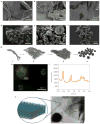Self-assembled RNA interference microsponges for efficient siRNA delivery
- PMID: 22367004
- PMCID: PMC3965374
- DOI: 10.1038/nmat3253
Self-assembled RNA interference microsponges for efficient siRNA delivery
Abstract
The encapsulation and delivery of short interfering RNA (siRNA) has been realized using lipid nanoparticles, cationic complexes, inorganic nanoparticles, RNA nanoparticles and dendrimers. Still, the instability of RNA and the relatively ineffectual encapsulation process of siRNA remain critical issues towards the clinical translation of RNA as a therapeutic. Here we report the synthesis of a delivery vehicle that combines carrier and cargo: RNA interference (RNAi) polymers that self-assemble into nanoscale pleated sheets of hairpin RNA, which in turn form sponge-like microspheres. The RNAi-microsponges consist entirely of cleavable RNA strands, and are processed by the cell's RNA machinery to convert the stable hairpin RNA to siRNA only after cellular uptake, thus inherently providing protection for siRNA during delivery and transport to the cytoplasm. More than half a million copies of siRNA can be delivered to a cell with the uptake of a single RNAi-microsponge. The approach could lead to novel therapeutic routes for siRNA delivery.
Conflict of interest statement
The authors declare no competing financial interests.
Figures





Comment in
-
siRNA delivery: Loaded-up microsponges.Nat Mater. 2012 Mar 22;11(4):268-9. doi: 10.1038/nmat3286. Nat Mater. 2012. PMID: 22437781 No abstract available.
-
siRNA as a sponge.Nat Methods. 2012 Apr;9(4):327. doi: 10.1038/nmeth.1965. Nat Methods. 2012. PMID: 22563602 No abstract available.
Similar articles
-
Mono-arginine Cholesterol-based Small Lipid Nanoparticles as a Systemic siRNA Delivery Platform for Effective Cancer Therapy.Theranostics. 2016 Jan 1;6(2):192-203. doi: 10.7150/thno.13657. eCollection 2016. Theranostics. 2016. PMID: 26877778 Free PMC article.
-
siRNA delivery: Loaded-up microsponges.Nat Mater. 2012 Mar 22;11(4):268-9. doi: 10.1038/nmat3286. Nat Mater. 2012. PMID: 22437781 No abstract available.
-
Lipid nanoparticles for short interfering RNA delivery.Adv Genet. 2014;88:71-110. doi: 10.1016/B978-0-12-800148-6.00004-3. Adv Genet. 2014. PMID: 25409604 Free PMC article. Review.
-
Polycation-based nanoparticle delivery for improved RNA interference therapeutics.Expert Opin Biol Ther. 2007 Dec;7(12):1811-22. doi: 10.1517/14712598.7.12.1811. Expert Opin Biol Ther. 2007. PMID: 18034647 Review.
-
siRNA release kinetics from polymeric nanoparticles correlate with RNAi efficiency and inflammation therapy via oral delivery.Acta Biomater. 2020 Feb;103:213-222. doi: 10.1016/j.actbio.2019.12.005. Epub 2019 Dec 6. Acta Biomater. 2020. PMID: 31812844
Cited by
-
Rolling Circle Transcription of Tandem siRNA to Generate Spherulitic RNA Nanoparticles for Cell Entry.Mol Ther Nucleic Acids. 2012 Aug 7;1(8):e36. doi: 10.1038/mtna.2012.31. Mol Ther Nucleic Acids. 2012. PMID: 23344178 Free PMC article. No abstract available.
-
Self-assembly of DNA nanohydrogels with controllable size and stimuli-responsive property for targeted gene regulation therapy.J Am Chem Soc. 2015 Feb 4;137(4):1412-5. doi: 10.1021/ja512293f. Epub 2015 Jan 26. J Am Chem Soc. 2015. PMID: 25581100 Free PMC article.
-
Charge-altering releasable transporters (CARTs) for the delivery and release of mRNA in living animals.Proc Natl Acad Sci U S A. 2017 Jan 24;114(4):E448-E456. doi: 10.1073/pnas.1614193114. Epub 2017 Jan 9. Proc Natl Acad Sci U S A. 2017. PMID: 28069945 Free PMC article.
-
Library siRNA-generating RNA nanosponges for gene silencing by complementary rolling circle transcription.Sci Rep. 2017 Aug 30;7(1):10005. doi: 10.1038/s41598-017-10219-y. Sci Rep. 2017. PMID: 28855687 Free PMC article.
-
Biodegradable poly (lactic acid-co-glycolic acid) scaffolds as carriers for genetically-modified fibroblasts.PLoS One. 2017 Apr 5;12(4):e0174860. doi: 10.1371/journal.pone.0174860. eCollection 2017. PLoS One. 2017. PMID: 28380080 Free PMC article.
References
-
- Semple SC, et al. Rational design of cationic lipids for siRNA delivery. Nature Biotechnol. 2010;28:172–176. - PubMed
-
- Mok H, Lee SH, Park JW, Park TG. Multimeric small interfering ribonucleic acid for highly efficient sequence-specific gene silencing. Nature Mater. 2010;9:272–278. - PubMed
-
- Liu L, et al. Self-assembled cationic peptide nanoparticles as an efficient antimicrobial agent. Nature Nanotechnol. 2009;4:457–463. - PubMed
Publication types
MeSH terms
Substances
Grants and funding
LinkOut - more resources
Full Text Sources
Other Literature Sources
Medical

